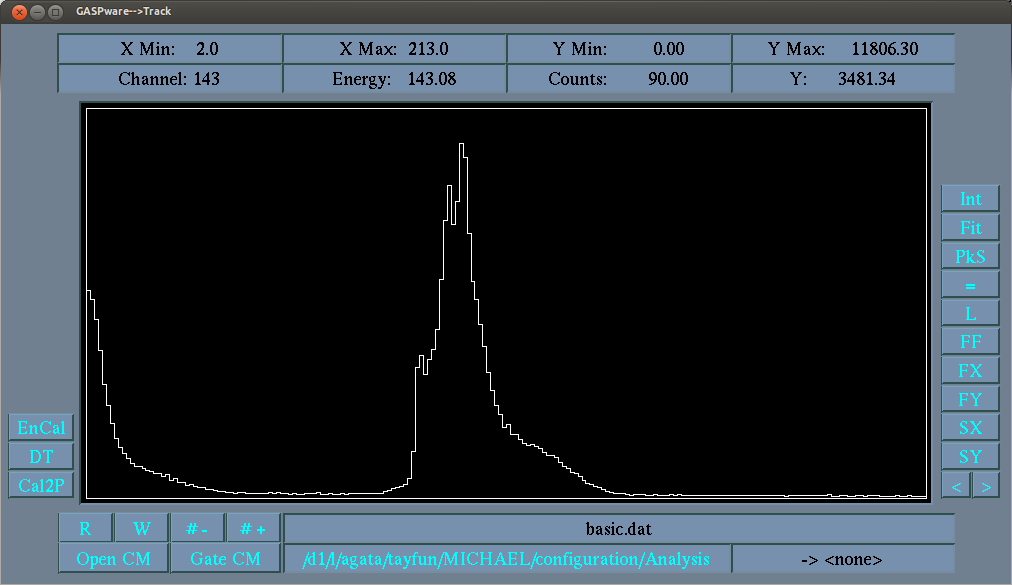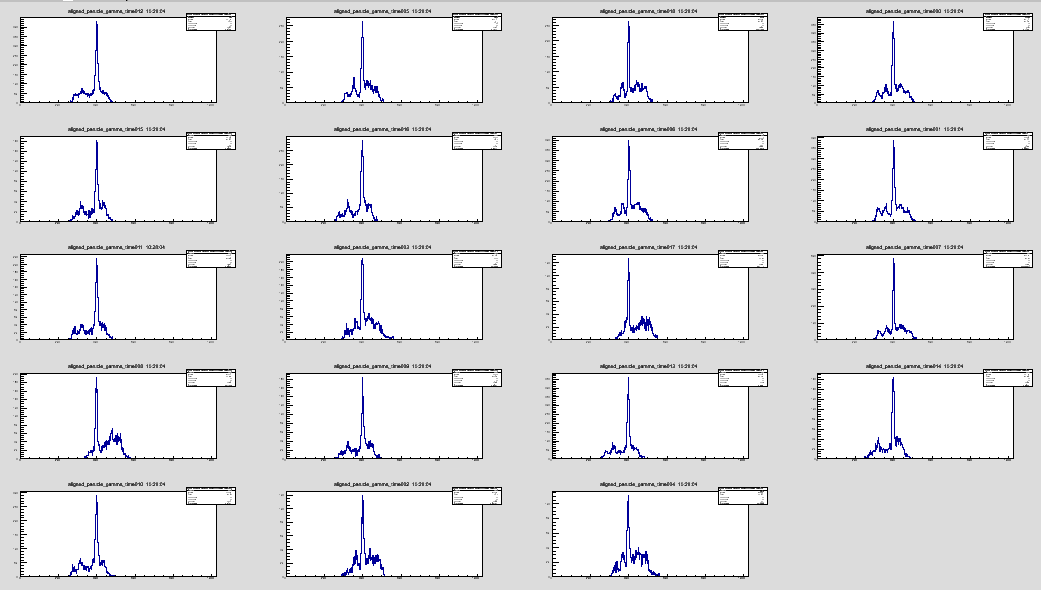Home » NUSTAR » NUSTAR PRESPEC » prespec data analysis package
| prespec data analysis package [message #16977] |
Thu, 10 July 2014 13:02  |
 thuyuk
thuyuk
Messages: 68
Registered: July 2014
|
continuous participant |

From: *ific.uv.es
|
|
Hi everyone,
Before to start my question, I should say that I'm using the configuration files from Michael.
My problem is related to the mapping of the ParticleGammaTime of Agata/Adapter processor in Agata.config file. The part of the config file I mentioned is like this in the original file provided by Michael:
particle_gamma_time[36] <- Agata/ParticleGammaTime.output[0]
particle_gamma_time[37] <- Agata/ParticleGammaTime.output[1]
particle_gamma_time[38] <- Agata/ParticleGammaTime.output[2]
particle_gamma_time[13] <- Agata/ParticleGammaTime.output[3]
particle_gamma_time[14] <- Agata/ParticleGammaTime.output[4]
particle_gamma_time[39] <- Agata/ParticleGammaTime.output[5]
particle_gamma_time[40] <- Agata/ParticleGammaTime.output[6]
particle_gamma_time[41] <- Agata/ParticleGammaTime.output[7]
particle_gamma_time[42] <- Agata/ParticleGammaTime.output[8]
particle_gamma_time[43] <- Agata/ParticleGammaTime.output[9]
particle_gamma_time[44] <- Agata/ParticleGammaTime.output[10]
particle_gamma_time[04] <- Agata/ParticleGammaTime.output[11]
particle_gamma_time[05] <- Agata/ParticleGammaTime.output[12]
particle_gamma_time[18] <- Agata/ParticleGammaTime.output[13]
particle_gamma_time[19] <- Agata/ParticleGammaTime.output[16]
particle_gamma_time[01] <- Agata/ParticleGammaTime.output[21]
particle_gamma_time[13] <- Agata/ParticleGammaTime.output[22]
I'm a little bit confused, because we had 19 crystals working during the commissioning runs and the experiments done in the 3rd quarter of 2012. But, here, there are 17 of MH TDC channels are addressed to the input array particle_gamma_time. Also, it is not clear for me to understand, why, e.g., Agata/ParticleGammaTime.output[22] corresponds to particle_gamma_time[13]?
The original config file used to fill Agata/ParticleGammaTime.output array from the crate AgataTimeCrate, but in my case this crate is empty, and AgataTimeCrate2 has channels with the data. So, I set the config file to get the data from AgataTimeCrate2. But, the same confusion arose here, how could one know which member of ParticleGammaTime.output array corresponds to which member of particle_gamma_time input array? Because in case of AgataTimeCrate2, the occupied MH TDC channels are like this:
Agata/ParticleGammaTime.output[0]
Agata/ParticleGammaTime.output[1]
Agata/ParticleGammaTime.output[2]
Agata/ParticleGammaTime.output[3]
Agata/ParticleGammaTime.output[5]
Agata/ParticleGammaTime.output[6]
Agata/ParticleGammaTime.output[7]
Agata/ParticleGammaTime.output[8]
Agata/ParticleGammaTime.output[10]
Agata/ParticleGammaTime.output[16]
Agata/ParticleGammaTime.output[17]
Agata/ParticleGammaTime.output[18]
Agata/ParticleGammaTime.output[19]
Agata/ParticleGammaTime.output[20]
Agata/ParticleGammaTime.output[21]
Agata/ParticleGammaTime.output[22]
Agata/ParticleGammaTime.output[23]
Agata/ParticleGammaTime.output[24]
Agata/ParticleGammaTime.output[26]
Thanks a lot in advance for your help!
Tayfun
|
|
|
|
| Re: prespec data analysis package [message #16980 is a reply to message #16977] |
Thu, 10 July 2014 18:49   |
 miree
miree
Messages: 71
Registered: June 2014
|
continuous participant |
From: *ikp.physik.tu-darmstadt.de
|
|
Hi Tayfun,
I think you got an old version of the AgataTimeCrate configuration.
Try to put only one time crate for AGATA like this:
crate AgataTimeCrate
procid 86
triggers all
module mhtdc LYCCA.v1290TMM triggers 2 3 5 6 7 8 9 10
module scaler LYCCA.v830 triggers 1 12 13
end
This contains a scaler and a multihit TDC that are read out on different triggers.
Assignments like "particle_gamma_time[36] <- Agata/ParticleGammaTime.output[0]" describe the mapping from the multihit TDC channel to the crystal-ID that provides the signals for the TDC channel. In this example, AGATA crystal 36 (=12A) was plugged (via a CFD) into channel 0 of the multihit TDC. How to find this assignment is described below.
The reason why you have 17 only, is that you based your analysis on the files for the performance commissioning. There were only 17 crystals in the setup. You need to find the two missing assignments (and verify the 17 assignments that are already there).
Another method to get the particle-gamma time is by using the following quantities:
a) time information inside the PSA frames (T0 and/or T1): This gives the difference between the GST timestamp of that PSA frame and the rising edge of the core signal.
b) the time difference between the Sc41 signal and the AGAVA accepted signal - both measured in one multihit TDC in the user crate.
c) the difference between the GTS timestamp of the MBS event and the GTS timestamp of the PSA frame.
The AgataAdapter processor computes from these quantities the particle-gamma time difference and provides it in the output arrays "core_pgtime_high" (using the T0 field in the PSA frame) and "core_pgtime_low" (using the T1 field in the PSA frame).
In order to do this, it needs the GTS timestamp from the AGAVA module
timestamp_agava_high24 <- TrloCrate.agava[1]
timestamp_agava_low24 <- TrloCrate.agava[2]
and the time difference (b), coming from a multihit TDC
dt_sc41_agava_acc <- Agata/Sc41Time.output[0]
The core_pgtime_high and core_pgtime_low arrays contain the information for all crystals. You can use this information to find which core signal was plugged into which multihit TDC channel by plotting all combinations of crystal-ID and multihit-TDC channel. For example with the following loop:
for $ch in [0:27]
for $id in [0:179]
processor Agata/Lut_Finder_$ch_$id UTILS.DoubleArray
x[0] <- Agata/ParticleGammaTime.output[$ch]
y[0] <- Agata/Adapter.core_pgtime_low[$id]
display x:y in Lut_Finder_$ch
end
end
end
Now, look for the plots that show the correct correlation between both quantities. If the combination of crystal-ID/multihit-channel is correct, you should get a plot similar to the one "TimeTime_good.png" (attached). For all wrong combination, the plot looks similar to "TimeTime_bad1.png".
Best regards,
Michael
|
|
|
|
|
|
| Re: prespec data analysis package [message #16990 is a reply to message #16989] |
Fri, 11 July 2014 13:17   |
 thuyuk
thuyuk
Messages: 68
Registered: July 2014
|
continuous participant |

From: *ific.uv.es
|
|
Hi Michael,
May I ask you to check AgataTimeCrate if you have missed something. Because, what you suggested doesn't work as it is.
Thank you,
Tayfun
edit:
sorry, it was my mistake. I was not able to see the error messages on Go4's terminal window as it moves rather fast. it was not related to the crate. it works now!
[Updated on: Fri, 11 July 2014 13:23] Report message to a moderator |
|
|
|
|
|
| Re: prespec data analysis package [message #17003 is a reply to message #16999] |
Mon, 14 July 2014 15:37   |
 miree
miree
Messages: 71
Registered: June 2014
|
continuous participant |
From: *ikp.physik.tu-darmstadt.de
|
|
Hi,
Typically the histogram with most counts is the correct one, because the others are only filled with random coincidences.
As far as I can see, most counts are in the top-left histogram (channel=0 crystal-id=004) in "agata_pgt_corr_all.png".
Can you choose a different binning, for example 500,0,300:500,600,1000 or even more centered around the spot in the middle 500,100,150:500,800,900? I think you'll be able to see the corellation there.
Michael
|
|
|
|
|
|
|
|
|
|
|
|
| Re: AGATA particle-gamma time [message #17082 is a reply to message #17081] |
Tue, 22 July 2014 10:56   |
 thuyuk
thuyuk
Messages: 68
Registered: July 2014
|
continuous participant |

From: *ific.uv.es
|
|
Hi Michael,
Thank you very much for the detailed description.
This is how the timedifference.dat peak looks like:

Regarding to the particle-gamma time from the MHTDC, I already aligned them for each crystal by setting the offset, and they look like this:

So, I'm sorry if I was not being clear in my previous mail, but the strange structure is due to the contribution from each crystal, i.e. in some cases the peak is on the left hand side of the distribution and in the others on the right hand side. The superposition of the spectra from 19 crystals produces the spectrum that I have put in my previous post.
The lines you suggested me were already in the config file, and the energy gate was set to: 565 - 3000. It's 3 times wider than you have suggested but it is still below the saturation bump and above the low energy region.
Cheers,
Tayfun
[Updated on: Tue, 22 July 2014 10:59] Report message to a moderator |
|
|
|
|
|
|
|
|
|
|
|
| Re: AGATA particle-gamma time [message #17283 is a reply to message #17278] |
Fri, 12 September 2014 11:50   |
 miree
miree
Messages: 71
Registered: June 2014
|
continuous participant |
From: *ikp.physik.tu-darmstadt.de
|
|
Hi Tayfun,
I have the following thoughts when I see this spectrum:
It seems that you have a correlation between energy and time.
My first impression regarding the asymmetric lines is, that they are supposed be on top (and not below) the "prompt flash" (i.e. the long horizontal line, indicating the particle impact). Maybe your time axis is reversed (i.e. later times are smaller numbers).
Second impression: Is one of the lines the 1461 keV 40K line? That would have to be perfectly symmetric, indeed! But I also think this should be much weaker. Perhaps you have some beam-induced background line that is at the same energy.
You seem to have very little neutron induced Ge(n,n' gamma)Ge background lines.
These are typically at energies: 585 keV, 563 keV, 595 keV, 689 keV, 1039 keV, 1368 keV
Your beam was 58Ni, and your projectile was 52Fe. It seems that more neturons come with heavier beams.
Perhaps you can make a time-gate before the promt flash [430 to 550] and try to identify the common Background lines (at least the 1461keV 40K should be there) in the projection.
Another question: What was your S4 particle rate (ions/sec)? Perhaps the strange-looking MH-TDC raw spectra are just showing additional particles in your event. You can also check the multiplicity in your MH-TDC modules (in particular the Sci41 multiplicity). Perhaps you have lots of events with two or more particles?
Best regards,
Michael
|
|
|
|
|
|
|
|
| Re: prespec data analysis package [message #17298 is a reply to message #16977] |
Tue, 16 September 2014 15:18  |
Damian Ralet
Messages: 35
Registered: July 2014
Location: Darmstadt
|
continuous participant |
From: *dynamic.qsc.de
|
|
Hi Tayfun,
Did you look at the time spectra with a trigger condition? For example, with a trigger 3, the background should be more dominent (Potassium, Cobalt, LaBr,...) and I would expect it uniformly distributed. I think, that the time structure will also take more understandable look with a trigger 9 (particle + gamma + lycca).
Cheers,
Damian
|
|
|
|
Goto Forum:
Current Time: Sat Jul 05 15:11:35 CEST 2025
Total time taken to generate the page: 0.00722 seconds
|
 GSI Forum
GSI Forum



